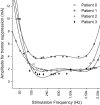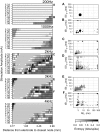Kilohertz Frequency Deep Brain Stimulation Is Ineffective at Regularizing the Firing of Model Thalamic Neurons
- PMID: 27014047
- PMCID: PMC4791372
- DOI: 10.3389/fncom.2016.00022
Kilohertz Frequency Deep Brain Stimulation Is Ineffective at Regularizing the Firing of Model Thalamic Neurons
Abstract
Deep brain stimulation (DBS) is an established therapy for movement disorders, including tremor, dystonia, and Parkinson's disease, but the mechanisms of action are not well understood. Symptom suppression by DBS typically requires stimulation frequencies ≥100 Hz, but when the frequency is increased above ~2 kHz, the effectiveness in tremor suppression declines (Benabid et al., 1991). We sought to test the hypothesis that the decline in efficacy at high frequencies is associated with desynchronization of the activity generated within a population of stimulated neurons. Regularization of neuronal firing is strongly correlated with tremor suppression by DBS, and desynchronization would disrupt the regularization of neuronal activity. We implemented computational models of CNS axons with either deterministic or stochastic membrane dynamics, and quantified the response of populations of model nerve fibers to extracellular stimulation at different frequencies and amplitudes. As stimulation frequency was increased from 2 to 80 Hz the regularity of neuronal firing increased (as assessed with direct estimates of entropy), in accord with the clinical effects on tremor of increasing stimulation frequency (Kuncel et al., 2006). Further, at frequencies between 80 and 500 Hz, increasing the stimulation amplitude (i.e., the proportion of neurons activated by the stimulus) increased the regularity of neuronal activity across the population, in accord with the clinical effects on tremor of stimulation amplitude (Kuncel et al., 2007). However, at stimulation frequencies above 1 kHz the regularity of neuronal firing declined due to irregular patterns of action potential generation and conduction block. The reductions in neuronal regularity that occurred at high frequencies paralleled the previously reported decline in tremor reduction and may be responsible for the loss of efficacy of DBS at very high frequencies. This analysis provides further support for the hypothesis that effective DBS masks the intrinsic patterns of activity in the stimulated neurons and replaces it with regularized firing.
Keywords: computational model; conduction block; desynchronization; high frequency stimulation; informational lesion.
Figures









Similar articles
-
Amplitude- and frequency-dependent changes in neuronal regularity parallel changes in tremor With thalamic deep brain stimulation.IEEE Trans Neural Syst Rehabil Eng. 2007 Jun;15(2):190-7. doi: 10.1109/TNSRE.2007.897004. IEEE Trans Neural Syst Rehabil Eng. 2007. PMID: 17601188
-
Effects of ramped-frequency thalamic deep brain stimulation on tremor and activity of modeled neurons.Clin Neurophysiol. 2020 Mar;131(3):625-634. doi: 10.1016/j.clinph.2019.11.060. Epub 2019 Dec 26. Clin Neurophysiol. 2020. PMID: 31978847 Free PMC article.
-
Short pauses in thalamic deep brain stimulation promote tremor and neuronal bursting.Clin Neurophysiol. 2016 Feb;127(2):1551-1559. doi: 10.1016/j.clinph.2015.07.034. Epub 2015 Aug 20. Clin Neurophysiol. 2016. PMID: 26330131 Free PMC article.
-
Mechanisms of deep brain stimulation and future technical developments.Neurol Res. 2000 Apr;22(3):259-66. doi: 10.1080/01616412.2000.11740668. Neurol Res. 2000. PMID: 10769818 Review.
-
Deep brain stimulation for movement disorders before DBS for movement disorders.Parkinsonism Relat Disord. 2010 Aug;16(7):429-33. doi: 10.1016/j.parkreldis.2010.04.005. Epub 2010 May 14. Parkinsonism Relat Disord. 2010. PMID: 20471903 Review.
Cited by
-
Limited Sensitivity of Hippocampal Synaptic Function or Network Oscillations to Unmodulated Kilohertz Electric Fields.eNeuro. 2020 Dec 16;7(6):ENEURO.0368-20.2020. doi: 10.1523/ENEURO.0368-20.2020. Print 2020 Nov-Dec. eNeuro. 2020. PMID: 33328248 Free PMC article.
-
A Network Model of Local Field Potential Activity in Essential Tremor and the Impact of Deep Brain Stimulation.PLoS Comput Biol. 2017 Jan 9;13(1):e1005326. doi: 10.1371/journal.pcbi.1005326. eCollection 2017 Jan. PLoS Comput Biol. 2017. PMID: 28068428 Free PMC article.
-
Highly efficient modeling and optimization of neural fiber responses to electrical stimulation.Nat Commun. 2024 Aug 31;15(1):7597. doi: 10.1038/s41467-024-51709-8. Nat Commun. 2024. PMID: 39217179 Free PMC article.
-
A neural mass model to predict electrical stimulation evoked responses in human and non-human primate brain.J Neural Eng. 2018 Dec;15(6):066012. doi: 10.1088/1741-2552/aae136. Epub 2018 Sep 13. J Neural Eng. 2018. PMID: 30211694 Free PMC article.
-
Temporal interference stimulation targets deep brain regions by modulating neural oscillations.Brain Stimul. 2021 Jan-Feb;14(1):55-65. doi: 10.1016/j.brs.2020.11.007. Epub 2020 Nov 11. Brain Stimul. 2021. PMID: 33186778 Free PMC article.
References
Grants and funding
LinkOut - more resources
Full Text Sources
Other Literature Sources
Research Materials

